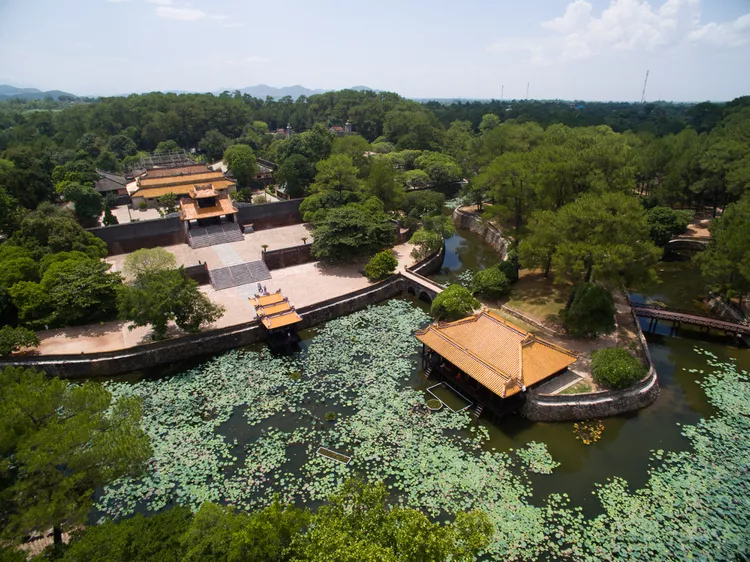Overview
- Things to Know Before Visiting Tu Duc Tomb
- Luu Khiem Lake, Tu Duc Royal Tomb
- Xung Khiem Pavilion, Tu Duc Royal Tomb
- Hoa Khiem Palace, Tu Duc Royal Tomb
- Throne at Minh Khiem Chamber, Tu Duc Royal Tomb
- Forecourt at Necropolis, Tu Duc Royal Tomb
- Stele Pavilion, Tu Duc Royal Tomb
- The Emperor’s Sepulcher, Tu Duc Royal Tomb
Tu Duc Royal Tomb in Hue, Vietnam
The Tu Duc Royal Tomb in Hue, Vietnam, is one of the remarkable Royal Tombs located on the outskirts of this former Imperial Capital. Built between 1864 and 1867, this tomb serves as a tribute to the fourth Nguyen Emperor’s long and troubled life.
Throughout his reign, Tu Duc faced numerous challenges, including rebellion and French incursions. Consequently, he spent his later years retreating into his tomb, where he could find solace through poetry and leisure amidst a lavish, serene environment.
In terms of scale and opulence, Tu Duc’s tomb stands unrivaled among the Royal Tombs in Hue. The architecture is seamlessly integrated with the scenic landscape, reflecting the Emperor’s desire for a harmonious retreat.
Things to Know Before Visiting Tu Duc Tomb
Getting to Tu Duc’s tomb: The site is located about four miles from Hue and is accessible via package tours, xe om, and cyclo drivers from the town center.
Operating Hours and Admission Fees: As of April 2015, the admission fee for Tu Duc’s Royal Tomb is VND 100,000 for adults and VND 20,000 for children under 12 years, payable at the entrance. The site operates from 8:00 am to 6:00 pm.
Must-Haves: Visitors should bring a parasol, sunglasses, and water during the sunny season (April-September) and an umbrella or raincoat during the rainy months (October-March). Comfortable shoes are essential for walking through the extensive grounds.
Luu Khiem Lake, Tu Duc Royal Tomb
The entrance to Tu Duc’s Royal Tomb is through the ornately decorated Vu Khiem entrance. Upon entering, visitors will walk approximately 400 feet along a ceramic-tiled path that hugs the right side of Luu Khiem Lake. Midway between Khiem Cung Gate (leading to Hoa Khiem Palace) and Du Khiem boat landing is an ideal stopping point to appreciate the area.
On the near shore of Luu Khiem Lake, you’ll find Du Khiem boat landing and Xung Khiem pavilion, both offering unique views and further exploration of the site.
Xung Khiem Pavilion, Tu Duc Royal Tomb
Xung Khiem Pavilion affords a beautiful view of Luu Khiem Lake, where the Emperor once relaxed with his concubines, reading and writing poetry. The pavilion has been restored and offers a delightful environment for informal gatherings and poetry readings.
To access Xung Khiem Pavilion, visitors must walk north approximately 100 feet from Du Khiem boat landing and turn left. The nearby Du Khiem boat landing was significant for the Emperor, providing a exit for his hunting trips on Tinh Khiem Island.
Hoa Khiem Palace, Tu Duc Royal Tomb
Khiem Cung Gate leads into the courtyard of Hoa Khiem Palace, the Emperor’s royal residence during visits. This palace later became a temple dedicated to his memory, housing many personal effects, including a gift from the French government and two thrones.
The construction of this magnificent palace and other elements of the tomb complex occurred from 1864 to 1867, and the immense labor and costs contributed to a tense relationship between the Emperor and his subjects.
Throne at Minh Khiem Chamber, Tu Duc Royal Tomb
The expansive palace complex, includes the Luong Khiem Temple and Minh Khiem Chamber, which was a venue for theatrical performances. Here, the Emperor engaged with classical Vietnamese drama, honoring local art forms.
For a nominal fee, visitors can dress in traditional attire and pose for professional photographs while immersing themselves in the rich cultural history.
Forecourt at Necropolis, Tu Duc Royal Tomb
Upon exiting the palace, the forecourt leads to the easternmost section of the tomb complex. This area is notably marked by smaller scaled figures of horses, elephants, and mandarins, representing the Emperor’s stature.
Stele Pavilion, Tu Duc Royal Tomb
The Stele Pavilion houses a significant 22-ton stone tablet detailing the Emperor’s life – a unique aspect, as he wrote this himself, reflecting on his reign and acknowledging shortcomings.
This is the largest stele in Vietnam, crafted with care over a lengthy four-year transport period from Thanh Hoa to Hue.
The Emperor’s Sepulcher, Tu Duc Royal Tomb
Walking about 200 feet west, visitors encounter the Buu Thanh wall surrounding the simple structure of the Emperor’s sepulcher. Notably, Tu Duc chose not to be buried here; his actual resting place remains unknown, as historical accounts note that the workers who buried him were executed to preserve its secrecy.
The subsequent rulers, including Tu Duc’s adoptive son Kien Phuc, faced their immediate demise shortly after taking power, further embedding the tomb in historical intrigue. Kien Phuc and the Empress Le Thien Anh’s resting places are both situated nearby, adding layers to the Tomb’s complex narrative.





